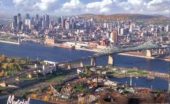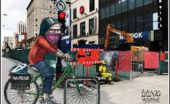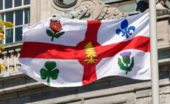Molly Minturn - My family is heartbroken to share that my father died in surgery on Monday, Feb. 10. It…
Montreal at the quarter century
Written by Diana Thebaud Nicholson // January 6, 2025 // Montreal // Comments Off on Montreal at the quarter century
Montreal at the quarter century: 25 ways the city has changed in 25 years
Allison Hanes
Some changes are obvious: The Farine Five Roses sign has graced the city skyline in some form since 1954. In 2017, to mark the 375th anniversary of the foundation of Montreal, the art installation Source, by Barcelona-born artist Jaume Plensa, was unveiled on Robert-Bourassa Blvd. downtown.
It seems like just yesterday that the world was bracing for computer-induced chaos with the arrival of Y2K. Now here we are at the start of 2025 with smartphones in our pockets and a generation of kids who have grown up with mobile devices in their hands.
A quarter century has flown by at warp speed.
This is one of those stop-and-take-stock moments, a time to reflect on how life in this city has evolved since the dawn of the new millennium. I’ve had a front-row seat on the last 25 years of Montreal history since I also happen to have started at The Gazette in the year 2000.
Some changes are obvious, like all the condo towers altering the skyline, or the colourful lights decking out both the Champlain and Jacques Cartier bridges. Social, political and economic shifts are more subtle to detect — some for the better, others definitely for the worse. And some things never change. Montreal roads are still pockmarked with potholes and we still fiercely love the Habs, even if they haven’t brought the Stanley Cup home since 1993.
Here are 25 ways Montreal has changed in 25 years — though there are surely countless more.
1. Merger and demergers
The map of Montreal has been modified — twice — since 2000, when the Parti Québécois government first introduced legislation on municipal mergers. On Jan. 1, 2002, Montreal became one island, one city as 28 municipalities were reduced to a single entity. But the loss of autonomy was so unpopular in Montreal’s former suburbs, Quebec Liberal leader Jean Charest promised a referendum on demerging during the 2003 election campaign. Once Charest was elected premier of Quebec, citizens in 15 former municipalities, including Westmount, Côte-St-Luc, Beaconsfield and Montreal East, voted to quit the megacity, while others like Lachine and Pierrefonds decided to stay put. So the island of Montreal is now a piece of Swiss cheese, with 16 cities and 19 boroughs
2. Montreal has received a major injection of diversity in the last 25 years
Over the centuries, waves of immigrants — Irish, Italian, Greek and more — have left their mark on Montreal and put their stamp on neighbourhoods. But Montreal has received a major injection of diversity in the last 25 years. “Visible minorities,” as people of diverse backgrounds were referred to in the 2001 census, then accounted for 14 per cent of greater Montreal’s 3.4 million residents. In the most recent 2021 census, 27 per cent of metropolitan Montreal’s population of 4.3 million identified as coming from different racialized or ethnic backgrounds. So the city’s demographics continue to evolve with the arrival of more Haitian, Middle Eastern, South Asian, African and Asian newcomers.
3. While Montreal has evolved to become the third most multicultural region in Canada, the rest of Quebec accounts for 17 of the country’s 20 least diverse communities in 2021. This contrast has widened social, cultural and political cleavages between the metropolis and the ROQ. As the first decade of the 2000s drew to a close, there were endless debates about reasonable accommodation — how far the majority should go in making concessions to minority groups on issues big and small. This included whether the Parc Ave. YMCA should frost its windows at the behest of an ultra-Orthodox Jewish congregation to shield spandex-clad women from public view, and whether a Sikh boy had the right to carry his ceremonial kirpan to school. A public commission presided over by scholars Charles Taylor and Gérard Bouchard was struck to make recommendations on how to live together harmoniously. The minority Parti Québécois government later made its proposed Charter of Values a wedge issue. And the Coalition Avenir Québec ultimately adopted Bill 21, a law that enshrines state secularism by forbidding public servants in a position of authority from wearing religious articles. The law is popular in the regions of Quebec where there are few minorities, but widely contested in diverse Montreal, demonstrating that the city has become an island in more ways than one.
4. Urban sprawl has led to congestion on highways heading off-island
The call of the suburbs has also been strong for many Montrealers. Families, a majority of them francophones, have left the city in search of their dream home, with soaring prices pushing many to drive until they qualify for a mortgage. Record numbers of people have moved beyond traditional bedroom communities into exurbs — once-rural towns on the periphery — contributing to urban sprawl. This pattern accelerated during the pandemic, so that by 2021, places even further afield, like Bromont and Ste-Agathe-des-Monts, saw significant boosts in their population. But don’t worry, Montreal has more than made up for the exodus with the arrival of young people and new immigrants.
5. A crisis of homelessness and vulnerability has gripped the city
Montreal used to be a renters’ paradise. In the good ol’ days you could get a 3 1/2 for a couple hundred bucks. Not any more. According to Centris, the average rent on the island of Montreal for the first quarter of 2024 was a steep $1,639. And Quebec has cracked down on the once-ubiquitous practice of lease transfers, which kept rents low indefinitely. Montreal, like many cities, is facing a crisis in the availability and affordability of housing caused by factors like the rise of short-term tourism rentals cannibalizing housing stock, record immigration and the slowing of new housing starts during and since the pandemic. The city is now facing an epidemic of homelessness and vulnerability while all levels of government look to invest in non-market housing.
6.Real-estate prices have also soared in Montreal.
Back in January of 2000, the average cost of purchasing a home in the city was $121,199 (including both houses and condos). In March of 2024, the average was $524,000, according to one study that tracked housing affordability in Canada over a quarter century. That’s a five-fold increase, but Montreal still remains relatively affordable compared to Vancouver and Toronto, where the average selling price is over $1 million.
7. Pedestrian-only streets have multiplied.
Prince-Arther St. between the Main and Carré St-Louis was once Montreal’s principal pedestrian strip, where you could sit on a terrasse, bring your own wine and eat grilled brochettes from the many Greek restaurants. The attraction fell on hard times and has been the target of many revitalization attempts. But it is no longer the only pedestrian drag. In recent years, thoroughfares such as Mont-Royal Ave., Wellington St. and Ste-Catherine St. E. have banished vehicles during the warm summer months and given themselves over to appreciative crowds on foot.
8. The number of bike lanes has exploded since former mayor Gérald Tremblay instituted the de Maisonneuve artery back in 2007.
Kamikaze bike couriers now share the road with Bixis as more and more Montrealers have embraced cycling. Current Mayor Valérie Plante constructed the REV on St-Denis St., a long-distance, north-south cycling corridor. There are now 1,065 kilometres of bike lanes in Montreal, according to the city, 729 kilometres of them open all year round. But pushback against new infrastructure nevertheless persists.
9. Former Montreal mayor Gérald Tremblay launched Bixi, Montreal’s iconic bike-sharing system, in 2009.
Tremblay turned out to be an unlikely bicycling visionary. Despite a rocky financial start, Bixi is now a Montreal success story. The 2024 season wrapped up with a record 13 million trips taken, a 15-per-cent bump in ridership. Bixi has since expanded to suburbs like Boucherville, Laval and Ste-Julie. And after a pilot project last winter, some Bixis will again be available all year round.
10. The days of elected officials vacationing on the yachts of construction magnates are long over in Montreal.
Investigative journalists, police and a public inquiry spent years exposing dubious schemes involving collusion, corruption and conflicts of interest in the awarding of public contracts. But there was a period of turmoil with frequent raids of public offices by UPAC, the Unité permanente anticorruption, and scandals ending political careers. Two Montreal mayors resigned under a cloud in less than a year: Tremblay in 2012 and Michael Applebaum in 2013. Applebaum was later convicted of fraud, while Gilles Vaillancourt, the longtime mayor of Laval, went to jail for taking bribes he stashed in a Swiss bank account. Montrealers were spellbound by the hearings of the Charbonneau Commission, where they heard Mr. Sidewalk try to explain police surveillance footage showing men stuffing cash in their socks at a café linked to the Mafia and learned how Mr. Three-Per-Cent demanded kickbacks from entrepreneurs in exchange for city contracts. Laws were tightened to reduce the rot and watchdogs set up to ensure constant vigilance. But corruption is sneaky and insidious, so who knows if it’s a thing of the past.
11. An injection of infrastructure
Montreal has experienced a construction boom in public infrastructure that includes the Grande Bibliothèque and two new superhospitals: the Centre hospitalier de l’Université de Montréal and the McGill University Health Centre. The Turcot interchange was overhauled and a new Champlain Bridge was constructed, while the old one rapidly deteriorated. The Orange Line of the métro was extended to Laval and the REM to the South Shore opened in 2023. REM lines to the West Island and Deux-Montagnes are set to start service in late 2025.
12. Orange Cones are part of the island scenery.
There has been so much construction — on highways, bridges, water mains and city streets — that the orange cone has become Montreal’s unofficial symbol. A 2023 study by the Chamber of Commerce of Metropolitan Montreal found 94 percent of streets in the heart of downtown had been obstructed over a one-year period, and some thoroughfares had been blocked repeatedly for years on end. The same analysis found 22 per cent of the orange cones were useless, leading Mayor Plante to vow to tame the zombie cones. Too late! A psychiatrist recently published a scientific article coining the term ”Montreal Syndrome” — an aversion to orange construction cones.
13. So many Montreal landmarks have vanished from venerable commercial strips.
Early in the 2000s, the Main lost Warshaw’s, Simcha and St. Lawrence Bakery. Later Euro-Deli, Buonanotte and ExCentris closed up shop. More recently, L. Berson and Sons Monuments decamped its gravestone shop to Ferrier St. in T.M.R. and Moishe’s picked up stakes and moved to Old Montreal. In the last two years, Slovenia butcher shop folded and the Main Deli shuttered. While St. Lawrence Blvd. has seen turnover and vacancies, St. Viateur has experienced gentrification. Higher rents and the arrival of chain stores drove away beloved mom and pop shops like S.W. Welch books and Le Cagibi. But other mainstays are thriving: You can now buy St. Viateur bagels in grocery stores and Café Olimpico has opened new locations in Old Montreal and downtown.
14. Quebec filmmakers conquered the world.
Xavier Dolan was a sensation at Cannes, starting in 2009. The late Jean-Marc Vallée’s 2013 film Dallas Buyers Club cleaned up at the Oscars. Denis Villeneuve hit the pinnacle of Hollywood success with blockbusters Blade Runner 2049 and Dune: Part One and Part Two.
15. In 2019, Amherst St. became Atateken, which means brotherhood and sisterhood in the Mohawk language.
Montreal sits on unceded Indigenous territory. Long before explorers arrived in the 1600s, Montreal was known as Tiohtià:ke to the Kanien’kehá:ka (Mohawk people) and Mooniyang to the Anishinaabeg people. But we have only just begun to acknowledge this history. In 2017, then-mayor Denis Coderre added the white pine to Montreal’s flag and coat of arms in a gesture of reconciliation.
16. On Nov. 5, 2017, Valérie Plante became Montreal’s first female mayor.
Women may have — shockingly — only been granted the right to vote in municipal elections in Montreal in 1970, but the city chose its first female mayor in 2017. Valérie Plante shattered the glass ceiling at City Hall and introduced gender parity on her executive committee, presiding over a council where women outnumbered men. She will wrap up her second term next year after being resoundingly re-elected in 2021.
17. Montreal is a greener city in many ways.
New parks now rival inconic Mount Royal in size. Parc Frédérick Back, in Villeray—St. Michel—Parc Ex, is an award-winning urban green space that replaced a former quarry and landfill. The Plante administration has acquired new tracts of land for the Grand parc de l’Ouest in the West Island, and the Grand parc de l’Est in the east end. The city recently purchased the bulk of the precious Technoparc Wetlands for preservation, a thriving ecosystem for more than 200 species of birds improbably nestled in St-Laurent’s industrial park.
18. Downtown is now competing with suburban mega malls like the Quartier Dix30, Carrefour Laval and Royalmount.
Retailers, along with the once-thriving garment and fashion industries, have been buffeted by changing trends including fast fashion, online shopping and big box stores. Indie boutiques often struggle to survive amid vacant storefronts on once-thriving commercial strips. Holt Renfrew and Ogilvy got a major makeover, as did the Eaton Centre (where the storied 9th floor restaurant recently reopened).
19. Cultural programming
The Quartier des spectacles didn’t exist 25 years ago, and now visitors can go skating there on the outdoor rink. Summer festivals draw crowds.
The Quartier des spectacles was constructed to offer a lively hub for the city’s cultural programming, including the Jazz Fest, FrancoFolies, Nuits D’Afrique, Montréal en Lumière and Nuit Blanche. Vast plazas were constructed around Place des Arts, along with a new Maison symphonique, an outdoor skating rink and shiny new towers to house organizations devoted to film, dance and the arts. But much of this came at the expense of the historic red light district on the Lower Main, where few vestiges of Montreal’s ribald heyday remain.
20. Osheaga has been a summer fixture since 2006.
POP Montreal and Osheaga didn’t exist 25 years ago. Since 2002, POP Montreal has become a mainstay on the local and international indie music scene. Since 2006, Osheaga has grown into a major international pop music festival, drawing crowds of 45,000 to hear headliners like Billie Eilish, Kendrick Lamar, Eminem, Lorde and Green Day.
21.The Big O is getting a new lease on life.
The Expos played their last game in Montreal on Sept. 29, 2004 and fans are still mourning. How Montreal lost its beloved Major League Baseball franchise is best left to my colleague Jack Todd to explain. Efforts led by Montreal businessman Stephen Bronfman to have a new stadium built in hopes of sharing a team with Tampa Bay have never gotten off the ground. But, the Big O, the Expo’s old home field, is getting a new lease on life. The roof and technical ring of the Olympic Stadium are finally being replaced at a cost of more than $800 million after decades of falling concrete and tears in its Kevlar dome rendered it frequently unsafe and unusable.
22.Women’s teams are giving Montreal fans something to cheer about.
The Montreal Victoire is now in its second season, winning over fans as part of the Professional Women’s Hockey League. And the Roses FC will bring Northern Super League soccer to Montreal starting this spring.
23. Some terrasses on Peel St. were shut down by fire inspectors last summer just as Grand Prix fun was getting started.
Montreal is renowned as a party town. But the city may be a little less fun these days, what with fire inspectors closing down terrasses on Peel St. just as Grand Prix weekend was getting into high gear last summer and the courts absurdly upholding a neighbour’s noise complaint against La Tulipe, a famed concert venue in the Plateau-Mont-Royal. The city has presented a new nightlife policy but some worry it could kill Montreal’s authentic vibe.
24. Bonjour/Hi Linguistic tensions have mostly simmered and sometimes flared over the years.
Linguistic peace has prevailed between the Two Solitudes for most of the last quarter century. Francophones and anglophones became more bilingual and put old grievances aside, especially younger generations who speak both languages with fluency and ease. The biggest language controversy of the previous decade was more of a joke. “Pastagate,” where the Office québécois de la langue française tried to order an Italian restaurant to use the French term for pasta on its menu back in 2013, made the watchdog a laughing stock and prompted its director to resign. But politicians have stoked old language tensions in recent years, taking aim at the Bonjour/Hi greeting used in many Montreal retail shops. And since Bill 96 was adopted in 2022 to strengthen protections for the French language, anglophones are feeling scapegoated and fear losing access to public services in English while their institutions come under attack.
25. As voters grow disenchanted with the CAQ, polls show a resurgence in PQ support.
In 2000, the dust had settled from the 1995 sovereignty referendum where the yes side fell short in a squeaker. Since 2003, when Quebecers elected a Liberal government that ruled for the better part of a decade and again from 2014 to 2018, the spectre of separation has been on the back burner. Save for 18 months, when the PQ returned to power as a minority government, Quebecers lost interest in the national question. The election of the Coalition Avenir Québec in 2018 seemed to confirm that the old sovereignist-federalist paradigm that had long dominated Quebec politics was passé. Premier François Legault is a nationalist who favours remaining within Canada, even if he is no friend of Ottawa. But as voters grow disenchanted with the CAQ, polls show a resurgence in PQ support. Even if the party holds only four seats in the National Assembly and backing for sovereignty rarely exceeds 30 per cent, Quebec may find itself going back to the future, deciding whether to stay or go it alone. But who will defend Canadian unity in a divided country where Western separatist movements are on the rise?



